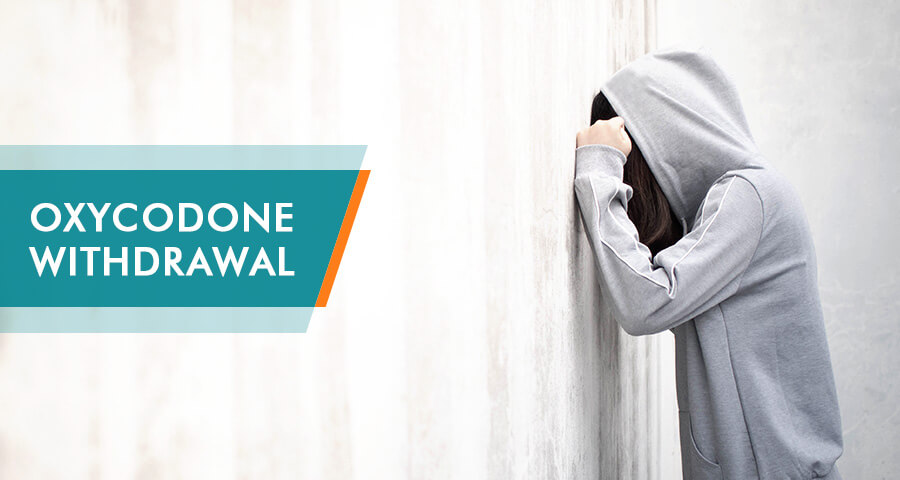Oxycodone Withdrawal Symptoms, Timeline, and Management

When it comes to drug abuse, prescription medication is the drug of choice for the majority of Americans. The National Institute of Drug Abuse has estimated that among Americans over the age of 12, around 20% have abused a prescription medication at least once. Oxycodone is high up on that list because of the intense effect it has on the pleasure centers of the brain when it is in use. However, Oxycodone withdrawal is a painful consequence of this abuse and addiction.
Table Of Contents:
Causes Of Oxycodone Withdrawal
When a person takes an opioid for a long time, their body slowly adapts to having it in the system. That leads to them needing to use the drug more to achieve the same “effects.” The body gets used to having the drugs in the system, and it can eventually alter the way the brain functions and affect the user’s overall mental and physical health. The drug becomes the center of all things, and the body and brain think they need it to function. That is the case if the drug is abused, especially if OxyContin and alcohol are mixed, and can still happen if taken as part of prescribed treatment.
When the user with the addiction to opioids stops using the drugs, their body starts reacting to the sudden change. This reaction is the body responding to the drug being withdrawn from the system. Comparing Hydrocodone vs. Oxycodone, both drugs are opioids, and their withdrawal will be similar.

Oxycodone withdrawal symptoms could be subtle changes in health, or the user can have a more severe reaction too; it may differ from person to person. Some will need a health care professional to help; others can take care of themselves and go through it on their own. It is recommended that the patient goes to a health care center to learn how to take care of themselves while going through it properly.
OxyContin Withdrawal Symptoms
Today, millions of people are addicted to opioids like Oxycodone (brand names OxyContin and Roxicodone), and those who try to break the addiction suffer severe Oxycodone withdrawal symptoms. However, it’s important to note that not everyone’s withdrawals work the same way.
Different people will react to the drug differently, and their bodies and brains respond to the withdrawal of the drug differently. Still, other factors can affect the way the OxyContin withdrawal symptoms manifest too.
These Include Things Such As:
- The last time the person took the drug
- Tolerance of the drugs
- The amount of time the drug was in use for
- Whether the drug was mixed with alcohol
- The amount of alcohol used
- The patient’s history of mental health issues or physical health issues
- The method used to use the drugs (oral, injection, snorting)
Opioids react differently for different people, that combined with all of these factors, they will affect the way their Oxycodone withdrawal symptoms manifest.
Still, There Are a Few Primary Symptoms That the Patient Should Look Out For, These Include:
- Nausea and vomiting
- Fatigue
- Coughing
- Diarrhea
- Runny nose
- Teary eyes
- Sweating
- Anxiety
- Shaking
- Twitching and kicking
- Muscle aches
- Increased heart rate
In addition to the physical effects, the psychological impact of Oxycodone withdrawal can make the process agonizing. These effects may linger longer than the physical side effects because it takes a while for the brain to restore its natural levels of chemicals responsible for positive emotions. It means that physical health and mental health can be affected in the process of recovery.
Some Psychological Effects You Can Expect to See During Oxycodone Withdrawal Include:
- Suicidal thoughts
- Depression
- Insomnia
- Irritability
- Confusion
- Mental ”fog”
- Apathy
- Trouble concentrating
However, staying off a drug is easier said than done. Subsequently, two significant factors play into Oxycodone withdrawal, which are the period and dosage tolerance.
How Long Is the Withdrawal From Oxycodone?
Withdrawals from Oxycodone typically last up to two weeks. The Oxycodone half-life ranges from 3 to 5 hours, which influences the withdrawal duration. The Oxycodone withdrawal timeline begins within 24 hours of the last intake and peaks around the second or third day after the symptoms start. This period has the most severe effects. Lesser symptoms of Roxicodone withdrawals may last for a few months.
Withdrawal Timeline
Time plays a vital role in Roxicodone withdrawals. Users who have been on the drug for years are likely to have more prolonged effects than those who have not. However, even those using it for only a few weeks or months may experience withdrawal. Just like the severity of the symptoms varies from person to person, so does the timeline.

The OxyContin withdrawal symptoms start to surface right after the drug has left the bloodstream, causing the user to experience the first signs of the grueling withdrawal process.
It usually begins within 24 hours after the last Oxycodone intake, reaching its peak around the onset of the second or third day of abstinence. At this stage, the symptoms are physical as well as psychological, lasting one to two weeks. In extreme cases, they may last even longer, leading to PAWS.
Post-Acute Withdrawal Syndrome
Post-Acute Withdrawal Syndrome (PAWS) is considered to be the “second stage of withdrawal.” That is when the brain is still dealing with the withdrawal of opioids from the system (although this can happen with other drugs, too). The brain is trying to rewire itself and recover back to the way it was supposed to be. This isn’t an easy task, and because of the intensity, the user may end up experiencing extreme symptoms for a longer time.
The symptoms associated with PAWS look almost identical to acute symptoms of the drugs leaving the system.
They Include:
- Problems with cognitive function
- Recurring cravings and urges for the drugs or alcohol
- Loss of motor skills
- Anxiety
- Depression and other mental effects
- Nausea and fatigue
- Mood swings
PAWS symptoms may seem similar to acute symptoms, but these can last for months or end at the start of the patient’s recovery. Therefore, it’s essential for the people suffering from the addiction to be aware of PAWS, so they can know that they’re not suffering from a permanent withdrawal and that it’s possibly the syndrome manifesting instead.
Easing Withdrawal Symptoms
To avoid severe Oxycodone withdrawal symptoms, users are advised to seek professional help and allow doctors at a healthcare/addiction support center to plan a weaning schedule. This way, the patient will not have to suffer the unbearable and life-threatening symptoms of Roxicodone withdrawals. Doctors at the center may also choose to prescribe Methadone as part of the treatment. Methadone is a partial opioid agonist which is often used to treat opioid-related addictions.
Overall, Oxycodone should only be taken under professional supervision and obtained with a doctor’s prescription.
Oxycodone Detox Centers
The best way to avoid the nasty symptoms is to go through the process with professional help. In specialized medical detox centers, one can begin before the symptoms have started while the drug is still active in the body. This is the ideal way to start the process. Next, the vital signs will be checked and monitored constantly for around a week. In extreme cases of long periods of addiction, a history of substance abuse, or heavy dependence on Oxycodone, this period can be extended to 10 days. Medication can be helpful to cope with severe symptoms.

This is the first step towards moving to a full recovery in substance abuse treatment programs. Medical Oxycodone detox is often a requirement for entering a recovery program so that the patient can concentrate with a clear mind on learning how to protect their health, new coping skills, and adapting to a drug-free life.
A health care professional can also guide a patient through everything with the use of medication-assisted therapy. That is a medical treatment program when different medications are prescribed to the former user to help with their withdrawal management.
The medications used will differ according to the level of symptoms that the patient is experiencing. The mild to moderate symptoms can be treated using NSAIDs, acetaminophen, aspirin, and loperamide. However, for the more severe symptoms, doctors may use medications like Clonidine to ease the discomfort.
Studies show that Clonidine can reduce the intensity of symptoms anywhere between 50-75% making a recovery a lot easier for the patient.
Preventing Relapse
For full recovery to be possible and maintainable, one mustn’t be free to continue abuse after the initial detox. A comprehensive substance abuse treatment program lays down the foundations for recovery and provides medication to help prevent relapse.
Oxycodone relapse can be especially dangerous and potentially life-threatening. It is because, during continual use of a drug, your body builds up a tolerance towards it, requiring larger amounts of the drug to achieve the desired effect. If someone completes a detox and then returns to using the same amount they did before, their body may not be able to handle it, which can lead to a deadly Oxycodone overdose. That is especially dangerous if a person was snorting Oxycodone or injecting it. These routes of administration provide a quicker and stronger effect, which may cause a severe overdose.
That is a real concern, as annually, there are an estimated 15,000 deaths related to prescription pain pill overdoses, according to the Centers for Disease Control and Prevention. Medical help using medications provided by substance abuse treatment programs can help decrease cravings for the drug and hopefully prevent someone from returning to Oxycodone in the future.
Hope Without Commitment
Find the best treatment options. Call our free and confidential helpline
Most private insurances accepted
Page Sources
- NIDA. 2021, May 13. Misuse of Prescription Drugs Research Report, Overview https://www.drugabuse.gov/publications/research-reports/misuse-prescription-drugs/overview on 2021, August 4.
- NIDA. 2021, July 27. Drugs and the Brain. Retrieved from https://www.drugabuse.gov/publications/drugs-brains-behavior-science-addiction/drugs-brain on 2021, August 4
- Semel Institute for Neuroscience & Human Behavior. Post-Acute Withdrawal Syndrome (PAWS) https://www.semel.ucla.edu/dual-diagnosis-program/News_and_Resources/PAWS
- Kosten, T. R., & George, T. P. (2002). The neurobiology of opioid dependence: implications for treatment. Science & practice perspectives, 1(1), 13–20. https://www.ncbi.nlm.nih.gov/pmc/articles/PMC2851054/
- Stojek, A., Madejski, J., Dedelis, E., & Janicki, K. (1990). Correction of the symptoms of late substance withdrawal syndrome by intra-conjunctival administration of 5% homatropine solution (preliminary report). Psychiatria polska, 24(3), 195-201. https://pubmed.ncbi.nlm.nih.gov/2084727/
- Clinical Guidelines for Withdrawal Management and Treatment of Drug Dependence in Closed Settings. Geneva: World Health Organization; 2009. 3, Assessment and Treatment Planning Using the Stepped Care Approach. https://www.ncbi.nlm.nih.gov/books/NBK310659/?report=reader
- Miller N. S. (2004). Treatment of dependence on opiate medications. The virtual mentor : VM, 6(1), virtualmentor.2004.6.1.cprl1-0401. https://pubmed.ncbi.nlm.nih.gov/23260067/
- Centers for Disease Control and Prevention. Prescription Painkiller Overdoses in the US. https://www.cdc.gov/vitalsigns/PainkillerOverdoses/index.html

 Authored by
Authored by  Reviewed by
Reviewed by 


